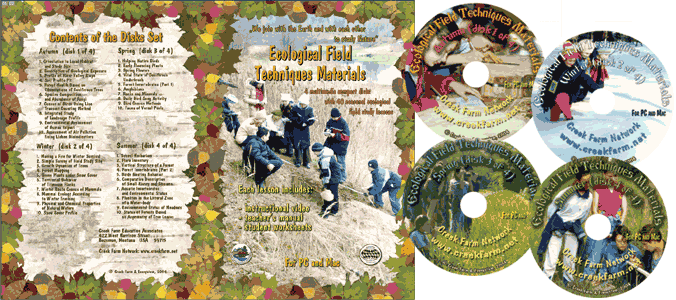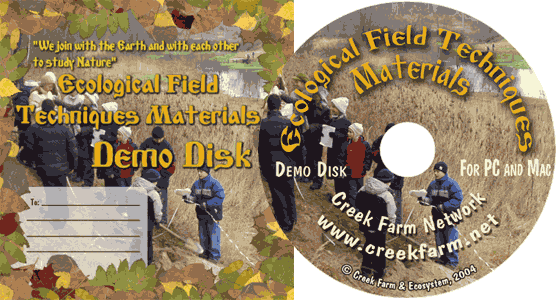|
| Our Field Ecology Center published more than
180 methodical materials for nature studies. Some of them are in English: |
|
|
|
Studies of Bird Populations Size by Different Methods
© Alexsander S. Bogolyubov,
Russia, 2002
© Michael J. Brody, USA,
2003
 This
manual describes three procedures for quantitative estimation of bird populations: route,
point and constant site (plot) censuses. Included are guidelines for
the organization, preparation (establishing a route and site selection), census
procedures, record-keeping and data processing. This
manual describes three procedures for quantitative estimation of bird populations: route,
point and constant site (plot) censuses. Included are guidelines for
the organization, preparation (establishing a route and site selection), census
procedures, record-keeping and data processing.
This field study has instructional video
featuring real students conducting the ecological field techniques in nature. Each video
illustrates the primary instructional outcomes and the major steps in accomplishing the
task including reporting the results.
Introduction
The following three types of bird census procedures are applied in most countries of
the world:
line transects (route census),
point census and
area mapping (plot census).
All three field study techniques (with associated international criteria) are approved
by the International Committee in Bird Census.
Determining which of the three census methods is most appropriate depends on the
purpose of study, peculiarities of the study site, season, bird numbers, time availability
and labor resources.
The route method is used most often to obtain approximate data on
numbers (relative density) of bird populations in different biotopes, when there is
small or inconsistent sizes of field study sites and a number of skilled observers.
Advantages of the route method include broad coverage of an area and seasonal and habitat
universality (census can be carried out in any season and in any habitat).
Disadvantages of the method are low accuracy of data on population density and the need
for skilled observers.
Point census is used for regular monitoring of changes in numbers of
different (model) species in a highly mosaic landscape and when monitoring is carried
out by amateur ornithologists who do not know birds well. Advantages of the method
include methodical simplicity of the census technique and low demand on observersТ
qualifications. Disadvantages are low accuracy of data on bird population density and the
need to adhere precisely to a number of standards in the course of the census.
Area mapping is used when it is necessary to obtain accurate data on absolute
numbers (density) of populations of different bird species at a specific study site.
Advantages of this method include high accuracy of data on bird populations density and
the possibility to conduct simultaneous studies of territorial behavior of birds.
Disadvantages of the method include; highly labor-intensive procedure, small
sample of field study site studied and limited available time (usually nesting
season).
In this lesson students will learn all three census techniques as they implement
each strategy simultaneously at the same study site. This approach allows students
to each conduct census as well as compare the effectiveness of the strategy, i.e.
efficiency, accuracy and labor intensity.
Organization of studies
Census territory
Any forested area is suitable including dense forests, gardens and parks, shrubbery
thickets both in mountains and on a plain. Dense forests on steep slopes or completely
open space will make these field studies difficult.
It is advised to choose a forest (or a site covered with vegetation) which is minimally
disturbed by human activity and which is not less than one square km in size. Route and
point censuses require lengthy sites while plot census can be carried out at a limited
forested site. We recommend to conducting these studies at the same site where route
censuses of birds were carried out in fall (Autumn Lesson #7). It is then possible to
compare characteristics of bird populations during non-nesting and nesting seasons.
Preparation for census
Students must be able to recognize bird species by their appearance and singing in the
course of any quantitative censuses of birds. Students will be estimating the numbers of
birds including birds seen at long distances and birds singing without actually being
seen. Students will need to determine the distances to birds and distances covered. Thus,
special attention should be paid to training of students while preparing for
implementation of the studies.
The most difficult aspect in conducting the bird census is determination of species. We
recommend starting practical training for censusing as early as possible. We
recommend teaching students to recognize bird songs during the entire spring, during
excursions or walks in the forest, or on camping tours. By the end of spring, (the most
favorable season for conducting...
This was only the first page from the manual and its full version you can see in the
Ecological Field Studies Techniques Video 4CD Set:
It is possible to purchase the complete set of 40 seasonal Ecological Field
Studies Techniques Video (in mpg format) in an attractive 4 compact disk set.
These compact disks are compatible with Mac and PC computers.
The videos are suitable for individual student or whole class instruction. To purchase the complete 4CD set
write to ecosystema1994@yandex.ru in a free form.

Ecological Field Studies Demo Disk:
We also have a free and interesting demonstration disk that explains our ecological field studies approach.
The demo disk has short excerpts from all the seasonal field study videos as well as sample text from all the teacher manuals.
The disk has an entertaining automatic walk through which describes the field study approach and explains how field studies meet education standards.
You can also download the Demo Disc from ecosystema.ru/eng/eftm/CD_Demo.iso.
This is a virtual hybrid (for PC and Mac computers) CD-ROM image (one 563 Mb file "CD_Demo.iso").
You can write this image to the CD and use it in your computer in ordinary way.
You also can use emulator software of virtual CD-ROM drive to play the disk directly from your hard disk.

|







